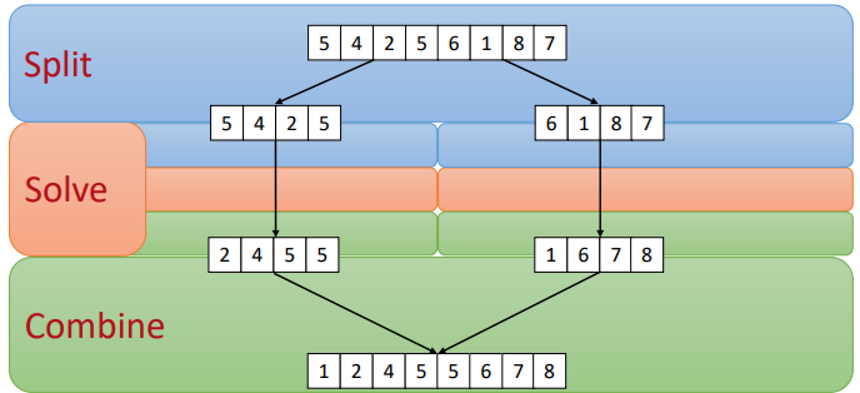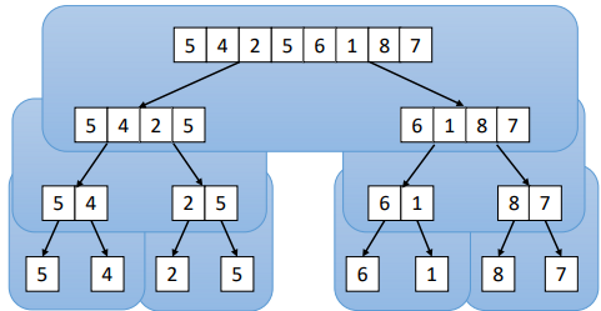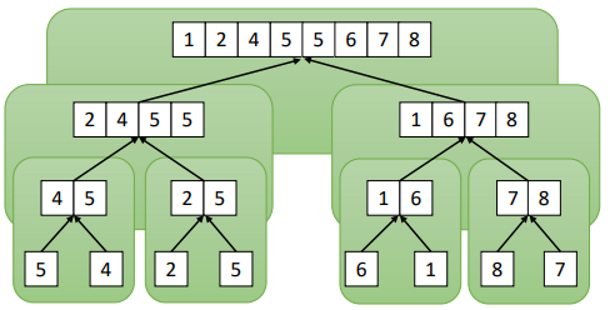Merge Sort
1/7
There's no tags or description
Looks like no tags are added yet.
Name | Mastery | Learn | Test | Matching | Spaced |
|---|
No study sessions yet.
8 Terms
Divide and Conquer Paradigm
The core idea is to decompose a problem into simpler sub-problems (of the same type)
Then, solve recursively on the sub-problems
Finally, combine the solutions for the sub-problems to get a solution of the original problem
Divide and Conquer in Merge Sort
Split: Split the input array into two equal halves
Solve: Recursively solve (i.e., sort) the two subarrays independently
Combine: Combine the two sorted subarrays by merging to get an overall sorted array

Top-Down Splitting

Bottom-Up Merging

Code
class MergeSort {
static void mergeSort(int array[]) {
int[] tmp = array.clone();
recursiveMergeSort(tmp, 0, array.length - 1, array);
}
static void recursiveMergeSort(int B[], int iStart, int iEnd, int A[]) {
if (iEnd == iStart) {
return;
}
int iMid = (iStart + iEnd + 1)/2;
recursiveMergeSort(A, iStart, iMid - 1, B);
recursiveMergeSort(A, iMid, iEnd, B);
merge(B, iStart, iMid, iEnd, A);
}
static void merge(int A[], int iStart, int iMid, int iEnd, int B[]) {
int i = iStart;
int j = iMid;
for (int k = iStart; k <= iend; k++) {
if (i < iMid && (j > iEnd || A[i] <= A[j])) {
B[k] = A[i];
i++;
}
else {
B[k] = A[j];
j ++;
}
}
}
}Correctness
for inputs of size ≤ n
for the easier merge sort, that creates temporary arrays in each split step
Prove by (strong) induction that Correctness(n) is true for all 𝑛 ≥ 1
Base step (for 𝑛 = 1):
Correctness(1) is clearly true, as an array with one entry is already sorted
Induction step (for 𝑛 > 1):
First, assume that the induction hypothesis holds for all integers 𝑛′ ≥ 1, 𝑛′ < 𝑛
Recall that Merge Sort splits an input array of size 𝑛 into two smaller arrays of size 𝑛/2 < 𝑛, and then recursively runs Merge Sort on each smaller array
The induction hypothesis holds for 𝑛/2 so the recursive calls return sorted arrays
Finally, the merging function successfully combines the two smaller, sorted arrays into the sorted version of the input array (of size 𝑛)
Worst-Case Time Complexity
for the easier merge sort, that creates temporary arrays in each split step
Cost of Operations:
Merging two arrays, of size 𝑘 each, takes 𝑐1𝑘 elementary operations
Splitting an array of size 𝑘 takes 𝑐2𝑘 elementary operations
Time Complexity:
𝑇𝑀(𝑛) is time complexity of Merge Sort when run on an input of size 𝑛
𝑇𝑀(𝑛) ≤ 2𝑇𝑀(𝑛/2) + (𝑐1 + 𝑐2) ⋅ 𝑛
Justification:
First, we split the array of size 𝑛
Then, we run Merge Sort on two different arrays, each of size 𝑛/2
Finally, we merge the two small (𝑛/2-sized) arrays
Analysis Summary
Best case - O(nlog(n))
Average case - O(nlog(n))
Worst case - O(nlog(n))
In-place - no
(best case and average case are implied by the worst case upper bound)